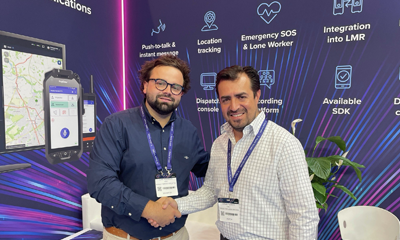How push-to-talk over cellular technology has increased in reliability over recent years.
Over the last few years, we have seen a significant increase in reliability of push-to-talk over cellular (PoC) technology due to rapid advancements in a number of key areas. These include network coverage, latency and the quality of the solution provider.
Modern push-to-talk cellular solutions now use advanced 4G LTE and 5G networks enabling them to deliver instant communication with noise cancellation and echo reduction features that provide clear audio in challenging environments.
Around 95% of the world’s population now have access to fast, reliable mobile broadband networks, increasing both accessibility to and reliability of PTT over cellular technology across the globe.
This blog examines why push-to-talk over cellular technology has become more dependable.
The evolution of push-to-talk over cellular technology
Push-to-talk (PTT) technology started with two-way radios in the early 20th century. Whilst these radio systems broke new ground, they have their limits, including needing their own infrastructure – which makes them costly to set up and run. Dead zones are also a problem because of buildings, mountains and other obstacles.
When innovators saw they could use existing cellular networks all this changed – and this new approach became known as push-to-talk over cellular (PTToC).
Network improvements (4G LTE & 5G)
PTToC (also known as PoC and PTX) works just like a walkie-talkie but with unlimited range. As the system uses cellular infrastructure, users can connect across the country or globally – without the need for special licenses or extra hardware.
The growth in mobile network coverage and the expansion and improvement of 4G/LTE and later 5G networks has improved the performance of PTT over cellular services, increased confidence in the technology and exposed the limitations of legacy radios.
The higher latency associated with PoC in the past was due to poor network conditions and congestion. Now, with the rollout of 4G LTE and 5G, PoC services experience significantly reduced latency, making communication almost instantaneous.
PTToC has also grown from simple voice calls into a complete platform. Now it handles multimedia messages and emergency alerts. Many PoC systems also integrate with GPS tracking for real-time location updates, improving worker safety and efficiency.
How 5G has transformed push-to-talk capabilities
5G technology has taken PTT over cellular reliability to new heights with market research showing exciting growth ahead. Today’s cellular networks support natural and quick communication across big geographical areas.
A number of 5G special features help PTToC systems:
- Network slicing lets operators create virtual networks just for PTToC traffic.
- Enhanced Quality of Service (QoS) controls keep PTToC messages flowing, even on busy networks.
- Advanced security features keep sensitive communications safe.
- Support for multimedia integration adds video calls and better awareness of situations.
In addition, PTToC communications can be carried out with higher bandwidth and faster data speed, resulting in lower latency and clearer and more seamless conversations – vital features for critical communications.
Reduced latency and improved audio quality
Better latency is the biggest technical improvement in modern PTToC systems. Leading providers like Mobile Tornado now offer:
- System availability of 99.999%
- Voice transmission delays under 0.5 seconds
- Call establishment and voice delay less than 300 milliseconds
PTToC systems now use advanced digital audio processing tech that delivers improved noise cancellation, giving users crystal-clear audio even in noisy industrial or outdoor environments.
.
Enhanced coverage through network densification
Network densification has brought reliable PTToC service to areas that used to have problems. Modern systems can switch between available providers automatically by using multiple cellular carriers and network infrastructures at once.
On top of that, devices can switch between Wi-Fi and cellular networks naturally, which keeps communication flowing wherever the user is located.
Redundancy and failover mechanisms
Modern PTToC systems leverage cloud infrastructure and use smart backup strategies to avoid single points of failure and increase their reliability. Local on-premise deployments are placed across regions to cut down on data travel distance. This regional approach creates multiple paths for routing, which helps keep things stable and ensure uptime when networks have problems.
Organisations that work across continents now have on-premise deployments and PTT servers in each major region, which stops voice data from taking unnecessary trips across continents.
How push-to-talk over cellular solutions outperform traditional systems
The increased reliability of PTToC systems means that they now outperform other communication technologies in several key areas. Whilst traditional radio systems are reliable in some situations, they have limitations that PTToC solutions easily overcome:
Enhanced coverage
PTToC technology’s biggest advantage comes from its extensive coverage which enables teams spread across different locations to communicate without investing in additional infrastructure.
Traditional radio systems need extra infrastructure like repeaters and base stations to extend their reach beyond a few miles line-of-sight range, whereas PTToC systems don’t face these constraints because they work anywhere with cellular service – nationally or internationally.
Signal strength is another major difference between the two systems. PTToC delivers better indoor coverage and eliminates many dead zones that traditional radio systems struggle with.
Improved security
Modern PTT over cellular platforms have much better security features than conventional radio systems. Traditional radios use open frequencies that anyone can listen to, while PTToC systems use advanced end-to-end encryption for secure communication making it very hard for unauthorised users to access the system.
PTToC platforms also have better authentication methods and remote management features that old systems lack. Users can remotely wipe or disable lost devices – something impossible with conventional radios.
Integration capabilities with other communication platforms
PTToC’s ability to work with other systems is another factor that makes it stand out. Traditional radio systems work alone, but PTT over cellular integrates smoothly with enterprise systems like dispatch consoles and management software for seamless operations. It works with various business systems and applications through APIs that enable custom integrations.
Modern PTToC solutions also work well with existing communication systems, including mobile data, video streaming services, and traditional radio systems through gateways. This compatibility creates a unified communication system that allows seamless communication and connects previously separate technologies.
Furthermore, some hybrid devices now support both PoC and traditional frequencies, giving users increased flexibility.
Conclusion
The rapid growth in the PTToC market reflects the increasing reliability of the technology. PTT over cellular delivers proven reliability that traditional radio systems can’t match – and with the expansion of 5G, this will only continue to improve.
Several key metrics measure and demonstrate reliability in PTToC communications. Modern systems deliver crystal-clear audio quality over huge distances and now reach 99.999% availability, a level that only military-grade communications achieved before. Call setup times have also got much better with industry leaders like Mobile Tornado now delivering voice transmission delays under 0.5 seconds and call set up times of less than 300 milliseconds.
In addition, PTToC offers global coverage and better indoor signal penetration, overcoming the range limitations and infrastructure requirements of traditional radio systems.
The system’s seamless integration with other communication platforms, its advanced encryption and security feature, and its resilient failover systems that keep the service running without interruption, make it a great choice for organisations that need dependable communication.
Find out more about how 5G is enhancing communication is critical sectors here.




